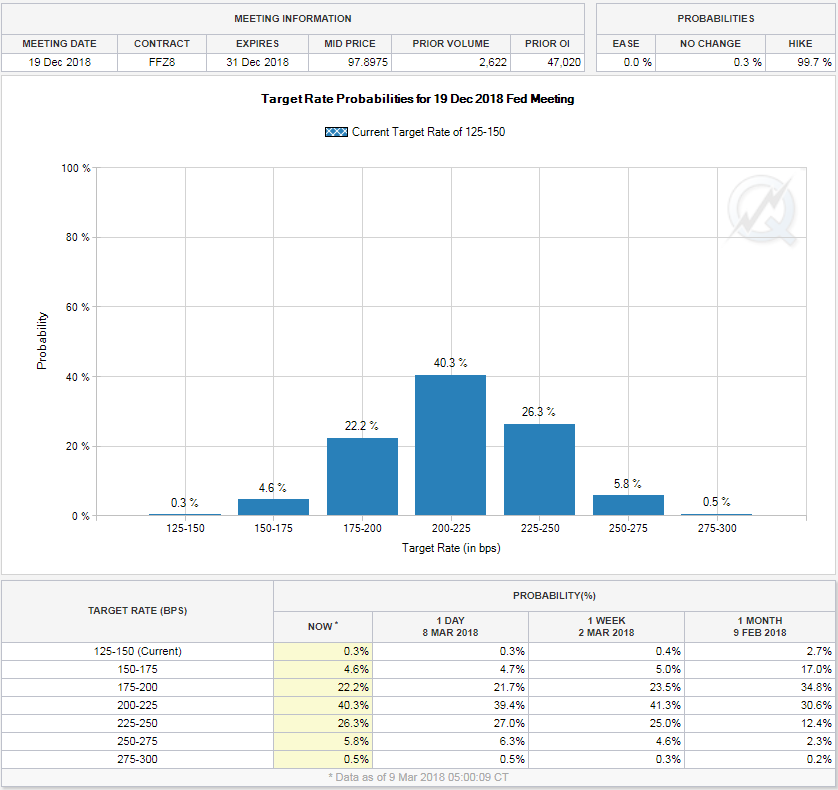- Investors Unimpressed With Tariffs Despite Softening of Measures;
- US Wages Eyed as Latest Jobs Data is Released;
- Labour Market Remains Strong in Cooling Canadian Economy.
Investors Unimpressed With Tariffs Despite Softening of Measures
Donald Trump’s tariffs on steel and aluminum are weighing on European markets a little this morning while US futures are pointing to a relatively flat open which suggests investors everywhere aren’t particularly thrilled by the prospects of retaliatory measures.
With NAFTA negotiations taking place, the decision to temporarily exempt Canada and Mexico from the tariffs, while leaving the door open for others to join them, has eased some concerns about the impact of the tariffs. The tariffs appear more a tool to bring countries to the negotiating table and address trade imbalances than the start of a trade war, despite Trump’s comments earlier in the week, but investors remain alert to the threat regardless.
US Wages Eyed as Latest Jobs Data is Released
The week so far has been dominated to such an extent by political stories and central bank announcements that the US jobs report, which is often the standout event of the week, has gone a little under the radar. This should not be taken as a sign that traders are not as focused on or bothered by it, they absolutely are. In fact, with the Federal Reserve pondering more rate hikes than previously hinted at, today’s jobs data could trigger quite a reaction in the markets.
The economy has been heating up for some time, which is why the central bank has been gradually raising interest rates in order to manage the situation before numerous sudden rate hikes are needed. The tax reform bill that was passed at the end of 2017 which will, at least in the near term, act as a stimulus for an already relatively hot economy and likely necessitate that the Fed raises interest rates faster than it was planning.

We now hear Fed officials talking about the possibility of four rate hikes this year, whereas before it was more like two or three. Gradually, investors are coming around to the idea of more hikes and this has contributed to the market becoming a little more volatile and unsettled. We’ve already had one correction of around 10% and stocks are yet to regain the heights they reached in January. They have stabilised though which is encouraging, given everything that’s happening at the moment.
Three rate hikes are now heavily priced in but there’s some way still to go on a fourth so this data will be important. While jobs growth of around 200,000 and unemployment falling to 4% is encouraging from an economic standpoint, it’s the wages number that will be of most interest to traders as this will have greater implications for inflation and spending. It’s expected to drop a little to 2.8% which is still up there with the highest we’ve seen since the financial crisis but if it can go above 3%, rate hike expectations could start to tick up again.

Labour Market Remains Strong in Cooling Canadian Economy
We’ll also get the Canadian jobs report today, which comes as the economy faces numerous challenges in the face of protectionism and NAFTA negotiations. The central bank has raised interest rates three times since the middle of last year and is likely to be active again this year, although they may be tempted to take their foot off the gas a little in the current environment.
Canadian unemployment has continued to fall and is now at pre-financial crisis lows, but growth and consumer spending has been falling since the middle of last year while inflation is below target and is not at a level that necessitates immediate action. Canada is expected to have created 20,000 jobs last year, with unemployment remaining at 5.9%.

Disclaimer: This article is for general information purposes only. It is not investment advice, an inducement to trade, or a solution to buy or sell securities. Opinions are the authors; not necessarily that of OANDA Corporation or any of its affiliates, subsidiaries, officers or directors. Leveraged trading is high risk and not suitable for all. Ensure you fully understand all of the risks involved and seek independent advice if necessary. Losses can exceed investment.
